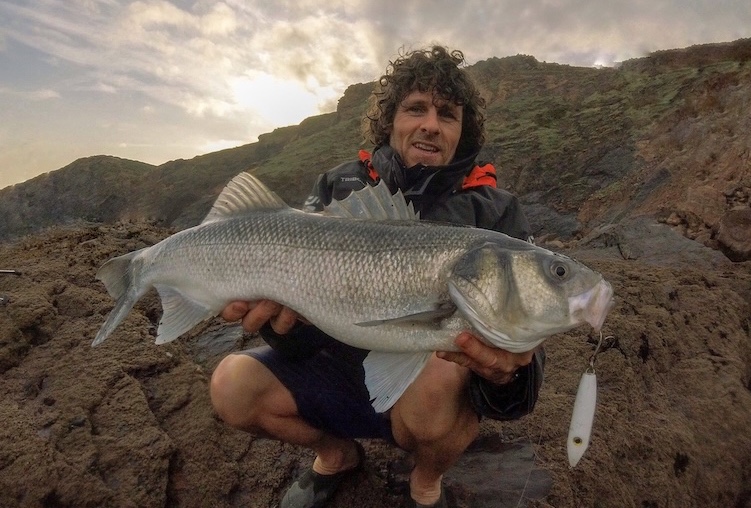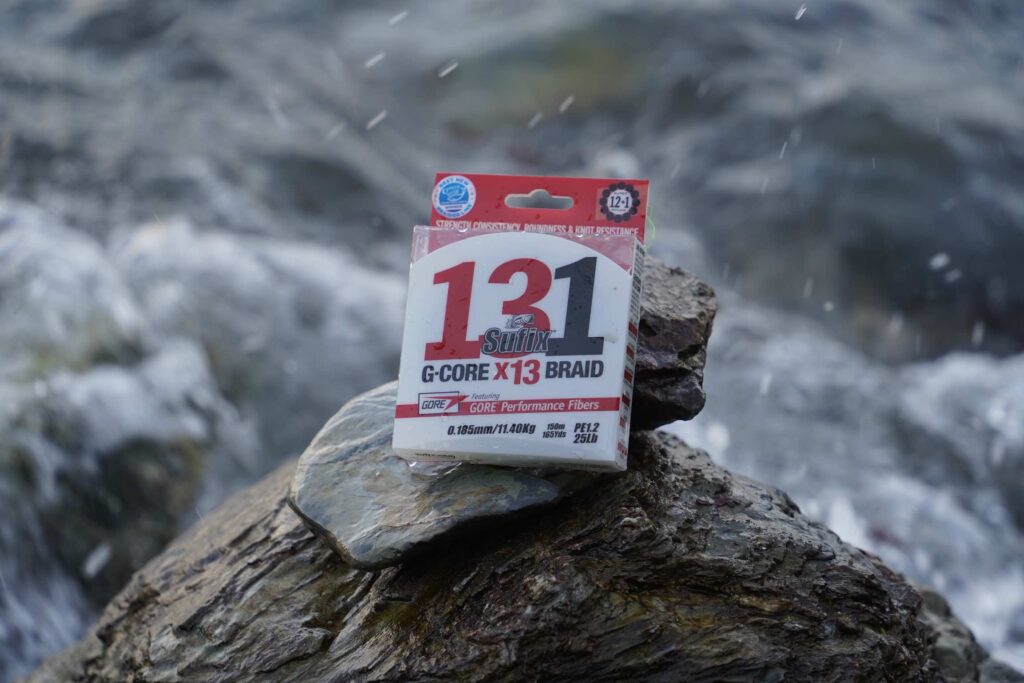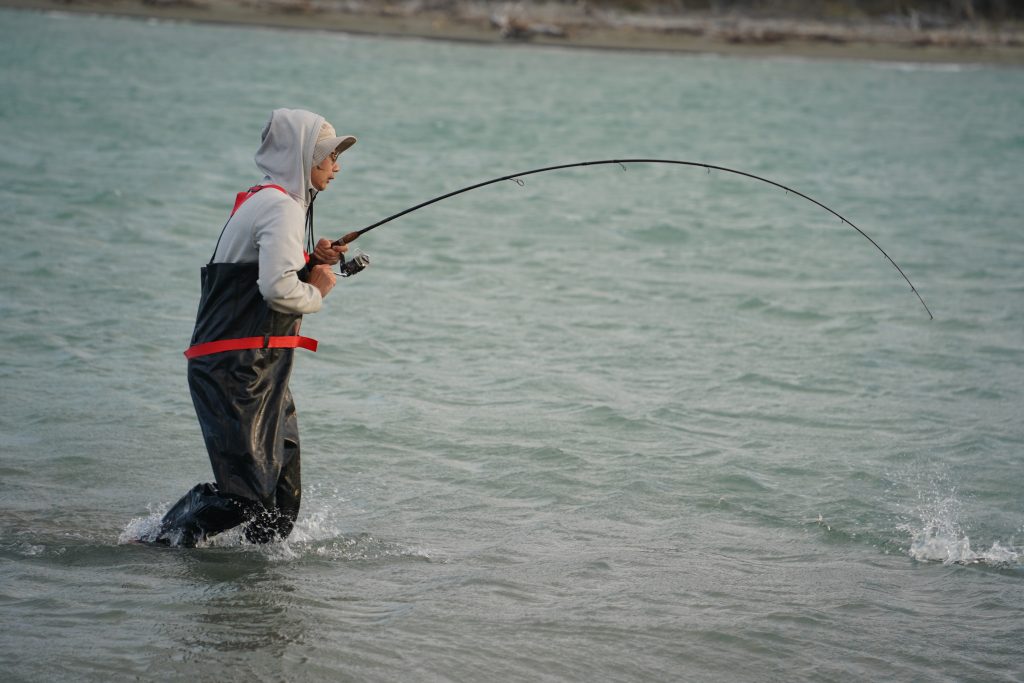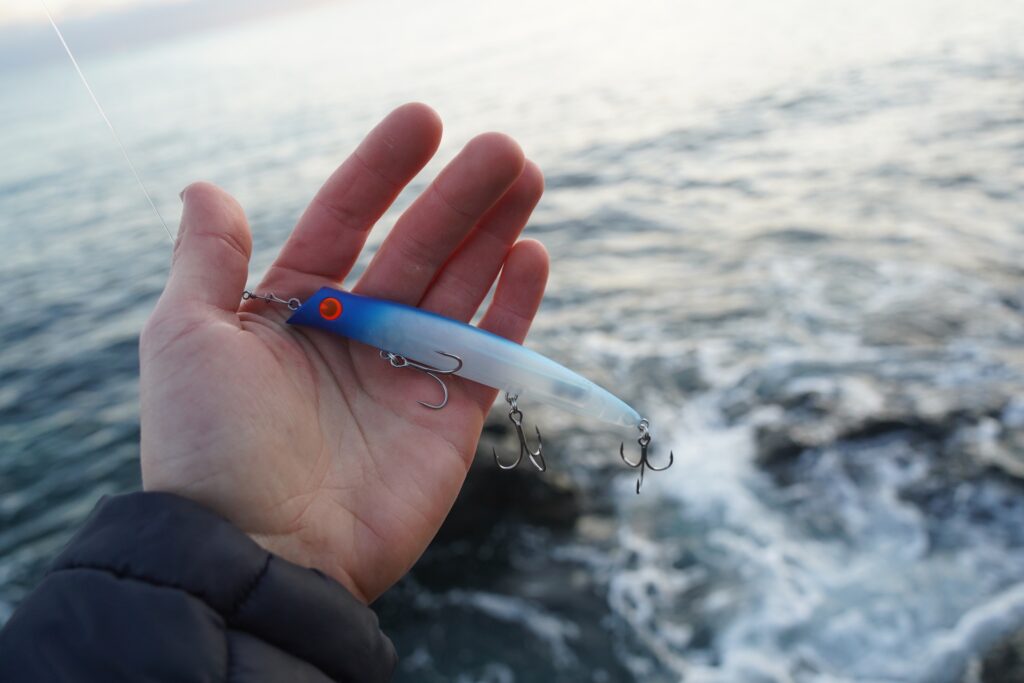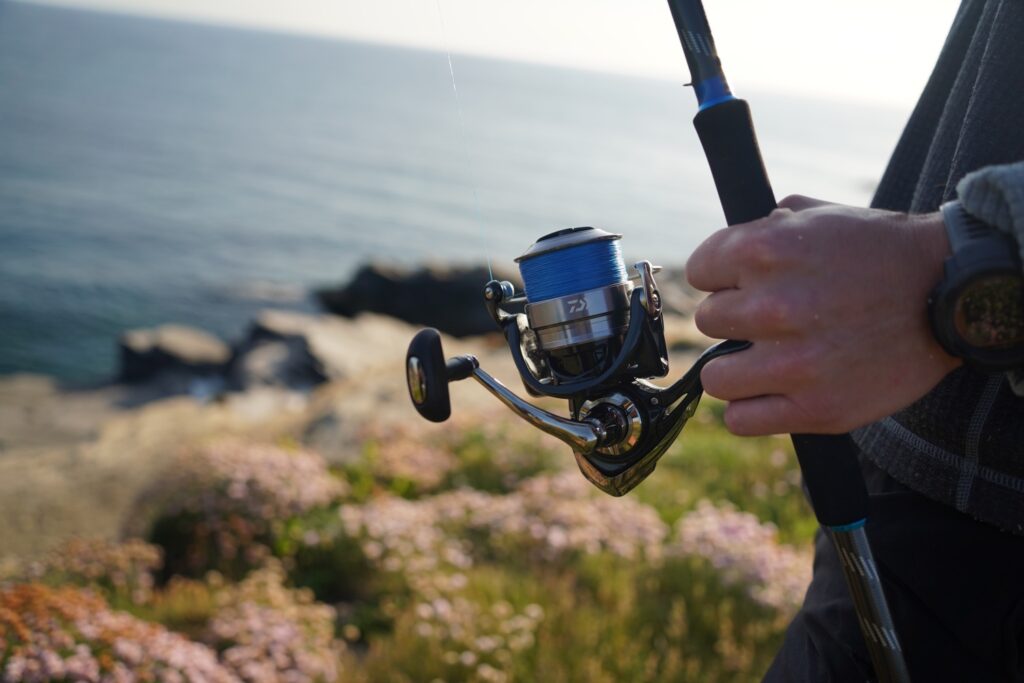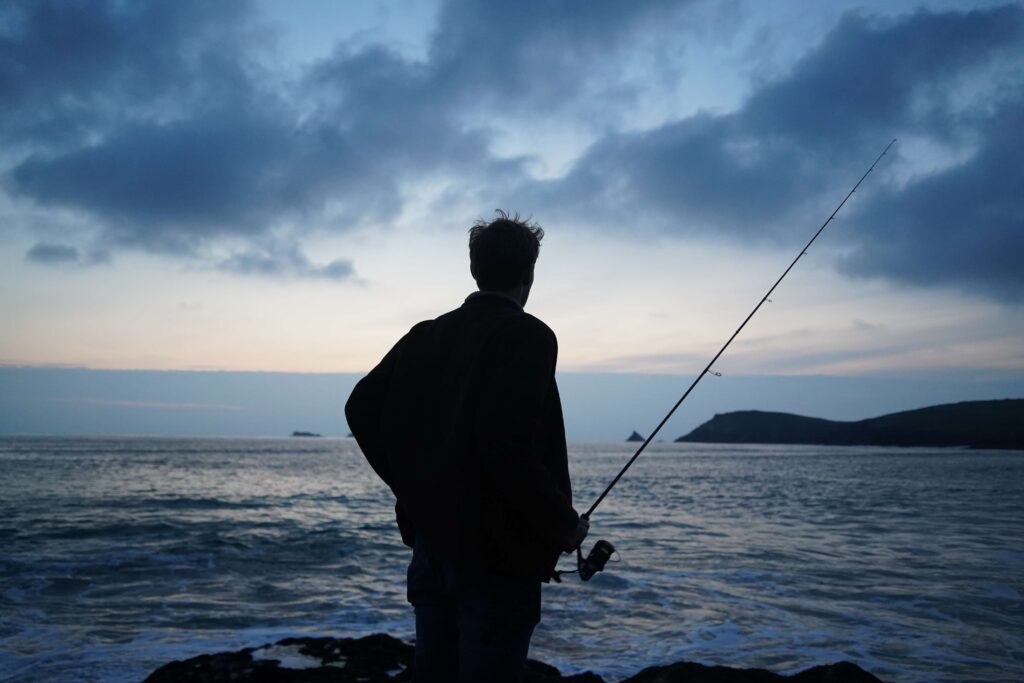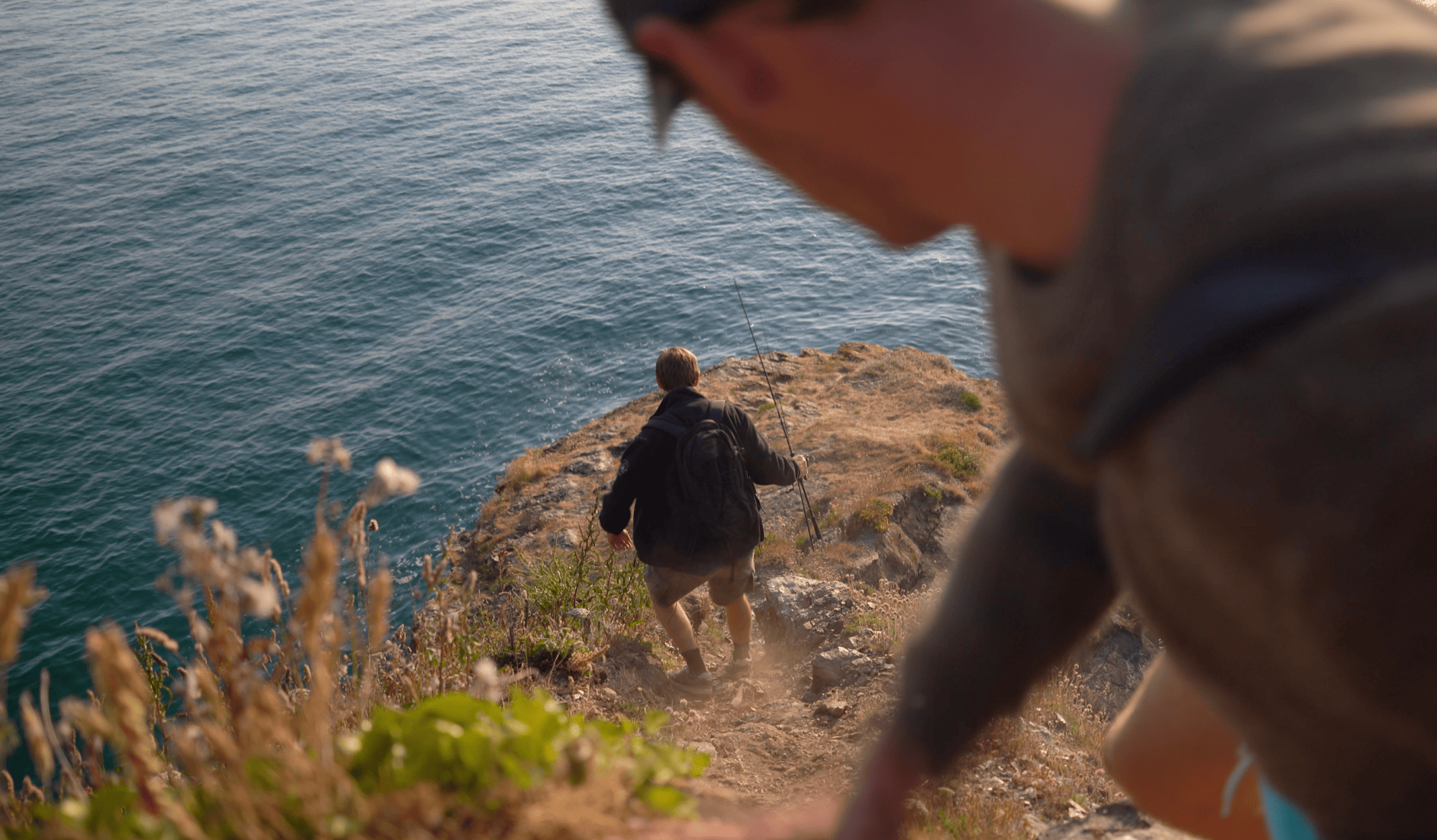
Rock Fishing with Lures
You’re sat, perching on a rock below a colony of cormorants. Each cast, dropping your lure into promising gullies, kelp forests and boulder fields. The goal is to tempt something out that’s lurking in the unknown.
You may be expecting pollack and catch a squid. You may be surprised by a fat bull seal, with a vibrant red wrasse hanging from its mouth. It’s not just the fishing that gets us clambering along the rocks. It’s the whole environment and all the unimaginable life that never fails to surprise.
Fishmag is reader-supported and earns commissions from affiliate sales, such as from amazon.
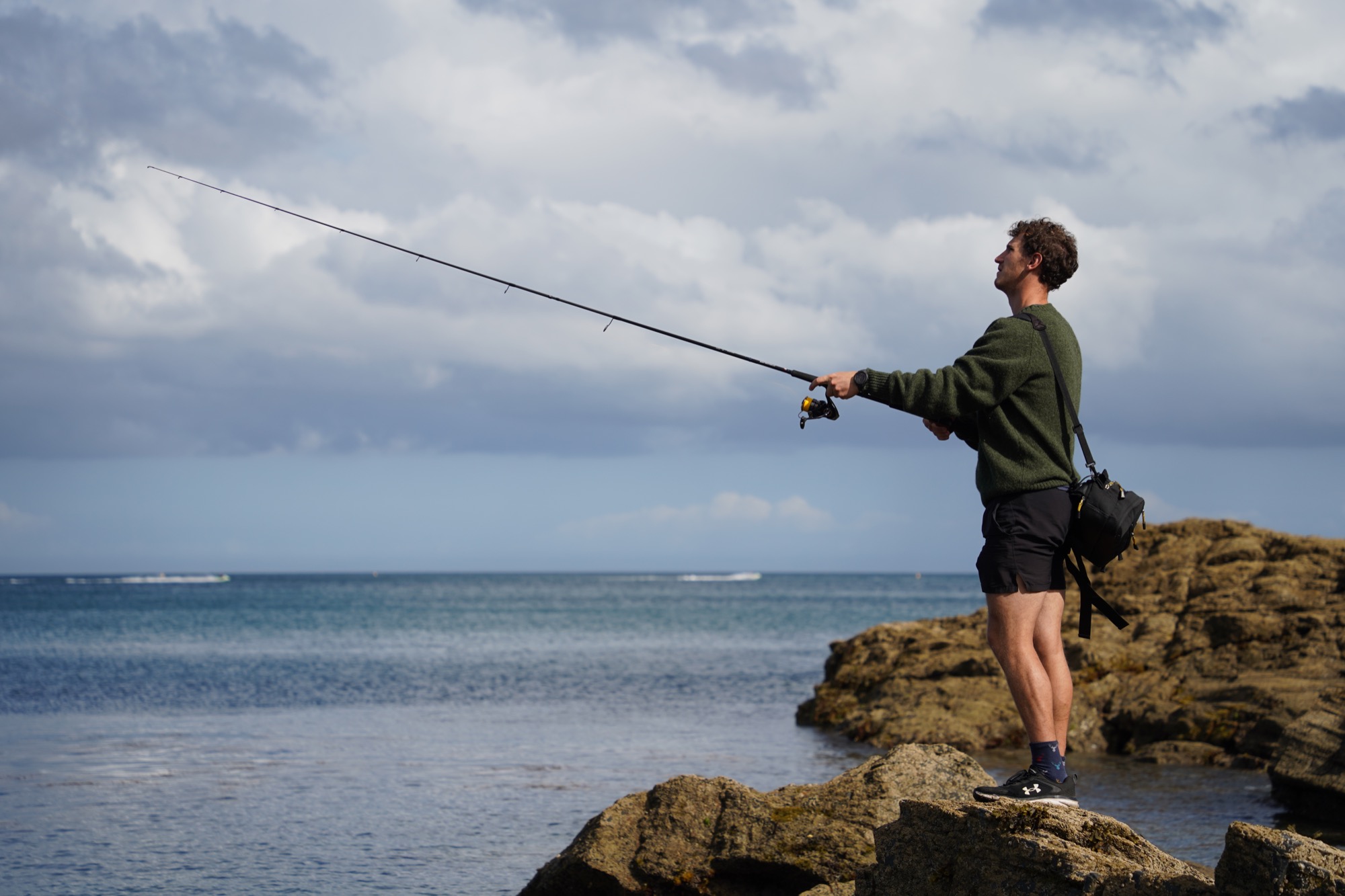
Patterns in the chaos
Rock fishing is about trying to discover patterns in the chaos of the sea. The best anglers look at the water and make predictions about what will be in it and how it will be behaving today… Usually with an exaggerated sense of certainty. They can often tell what species a fish is from the first bite before it’s hooked!
Despite this, there’s always a lot of randomness, and we just have to control what we can. You need to have nailed one or two basic knots. You need to understand a few different methods and when to use them. Crucially, you need the right tackle for the job.

Three methods for rock fishing with lures
A timeless classic…
Metal spinners like the dexter wedge and the sleek modern casting jigs that followed them both work. They are fantastic for a wide range of species. However, wedges are far more prone to snagging over rough ground. The jigs with smaller, single hooks perform much better in this aspect. The appeal of a metal is its ability to reach the horizon and fish at your chosen depth easily. It covers a lot of ground quickly and efficiently. This feature is great for rock fishing over clean or cleaner areas of ground. However, it leads to many snags over kelp and boulders.

Weedless soft plastics
Weedless hooks have existed for a long time. However, in recent decades, the soft plastics used with them have become more suitable for British fishing. People most commonly used jelly eels in weedless rigs. These are long, wormlike rubbers with a short curly tail at the end. They are effective, especially for pollack. However, for other species, there are better options. Many anglers in the UK, including myself, prefer paddle tails or straight lures over curly tails. Many of the more unusual and fascinating lures in the UK originate from American freshwater bass fishing. However, they don’t always adapt well to British fish species.
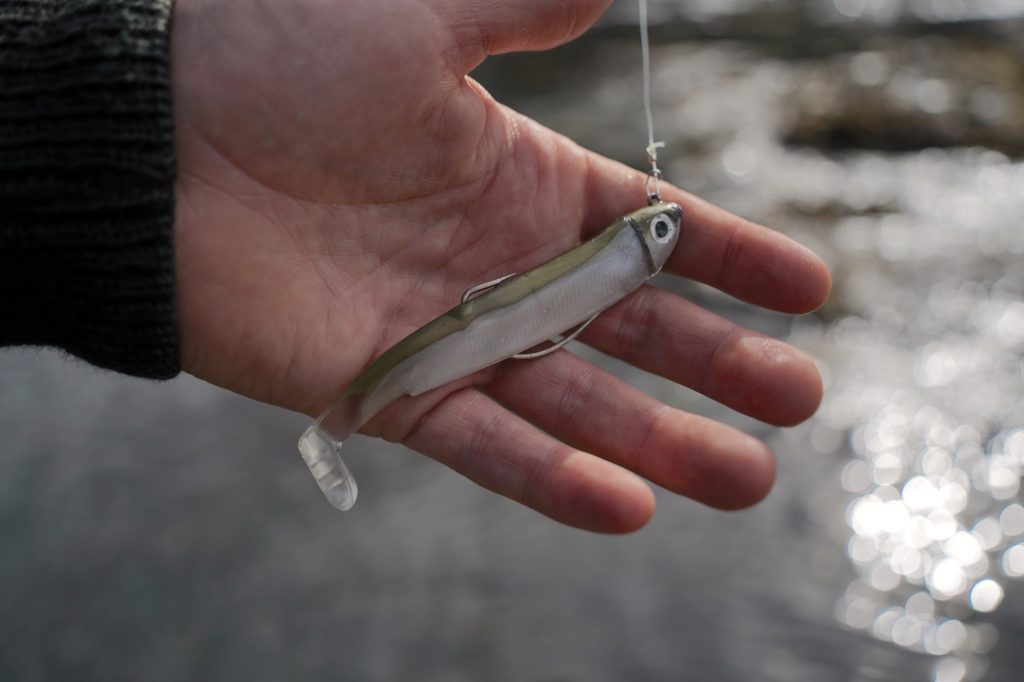
The Fish Minnow (above) is by far the most popular weedless lure in the UK.
I’ve noticed that in the Mediterranean, brighter colours, faster more erratic lure movements and flamboyant lures work very well. The water there is low in nutrients, so there is lots of light, making everything bright and colourful. The water is warm, so fish have higher metabolisms. They can afford to spend more energy chasing other fish, which makes them more impulsive.
Fish in competition will strike at lures they would otherwise avoid. In the UK, especially in colder water, I believe fish are generally more conservative. They favour slower-moving, less extravagant lures. God bless America, but many of their lures don’t match this description.
When it comes to weedless rigs, I recommend naturally coloured paddle tails and straight tails rigged with a texas rig. There, we’re still friends with the Americans after all…
All you need for fishing weedless:
- Weedless hooks between size 8 – 1/0
- Paddle tail or straight tail soft plastics of the right size for the hooks
- A fluorocarbon line you can tie to your braid as a leader
- If not using leader, just tie your monofilament line directly to the hook just after pushing on your cone weight.
This weedless rig is best fished by bouncing the lure along the bottom. Cast out and wait until the lure hits the kelp or rocks. Then, gently retrieve, aiming to keep the lure just above or on the sea bed.
A weedless lure is a special type of lure. It has a curved hook rigged on the soft plastic lure. The hook point is concealed in this setup. When a fish bites, the hook point becomes revealed. However, when you bounce your lure on or near the bottom, you lose less tackle with weedless rigs.
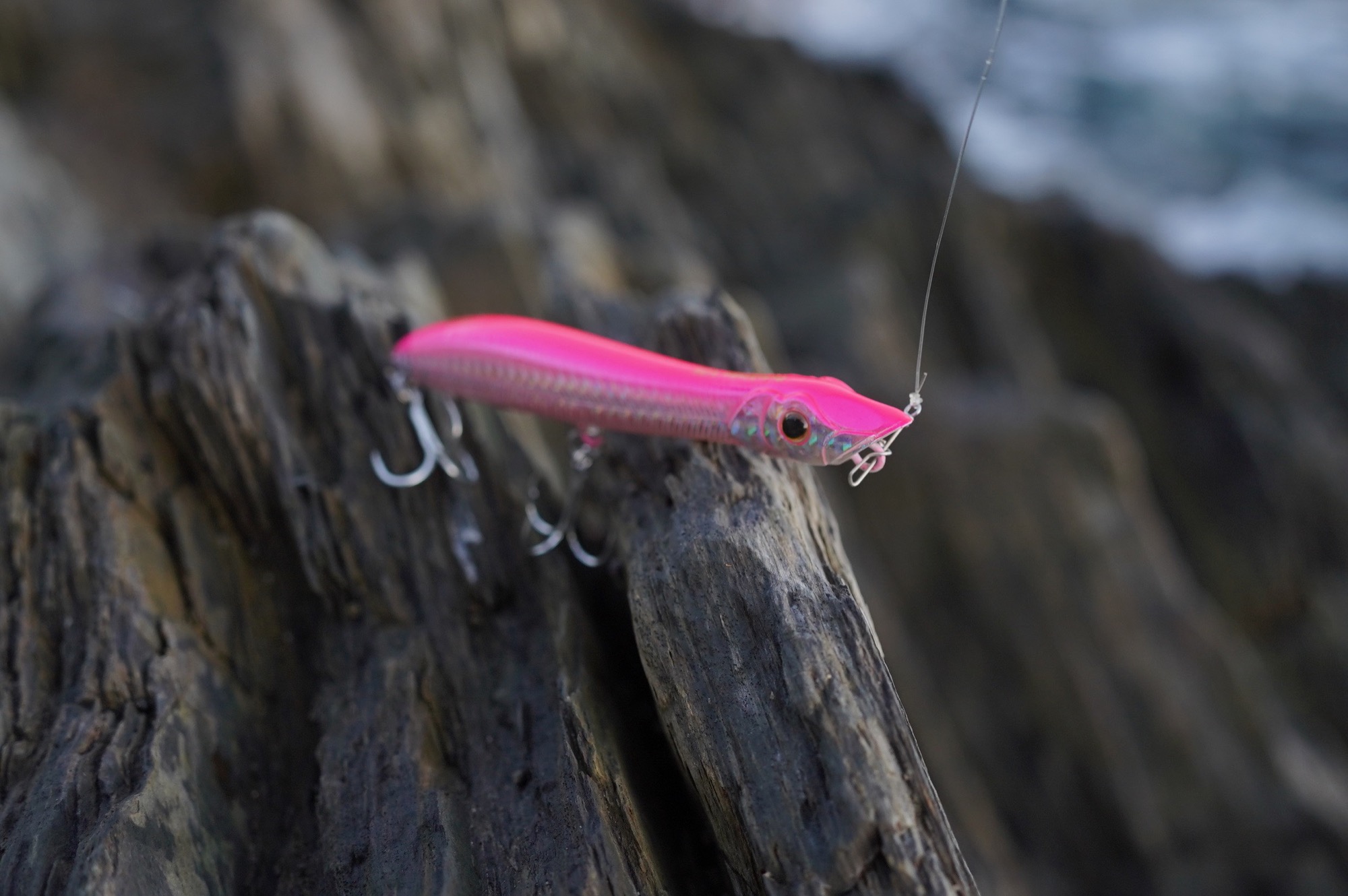
Surface fishing with poppers
Surface lures like the Pachinko are good for bass on late-summer evenings in the UK. Other species will hit them, too. This style of fishing is also great for avoiding snags since the lure floats well away from the weeds. It’s, therefore, possible to catch hundreds of fish on one lure until you eventually lose it, which saves you loads of money on lost lures in the long run.
Typically, people fish these poppers in a ‘walk-the-dog’ style. This style involves moving your rod tip sharply from left to right while retrieving slowly. The lure zig-zags and thrashes about on the surface back to you. Often, bass swim up to grab your lure just as you lift the popper from the water. I recommend switching the treble hooks from plugs like the Pachinko if you can. This change can reduce damage to fish. This is especially important as most bass fishing is catch and release.
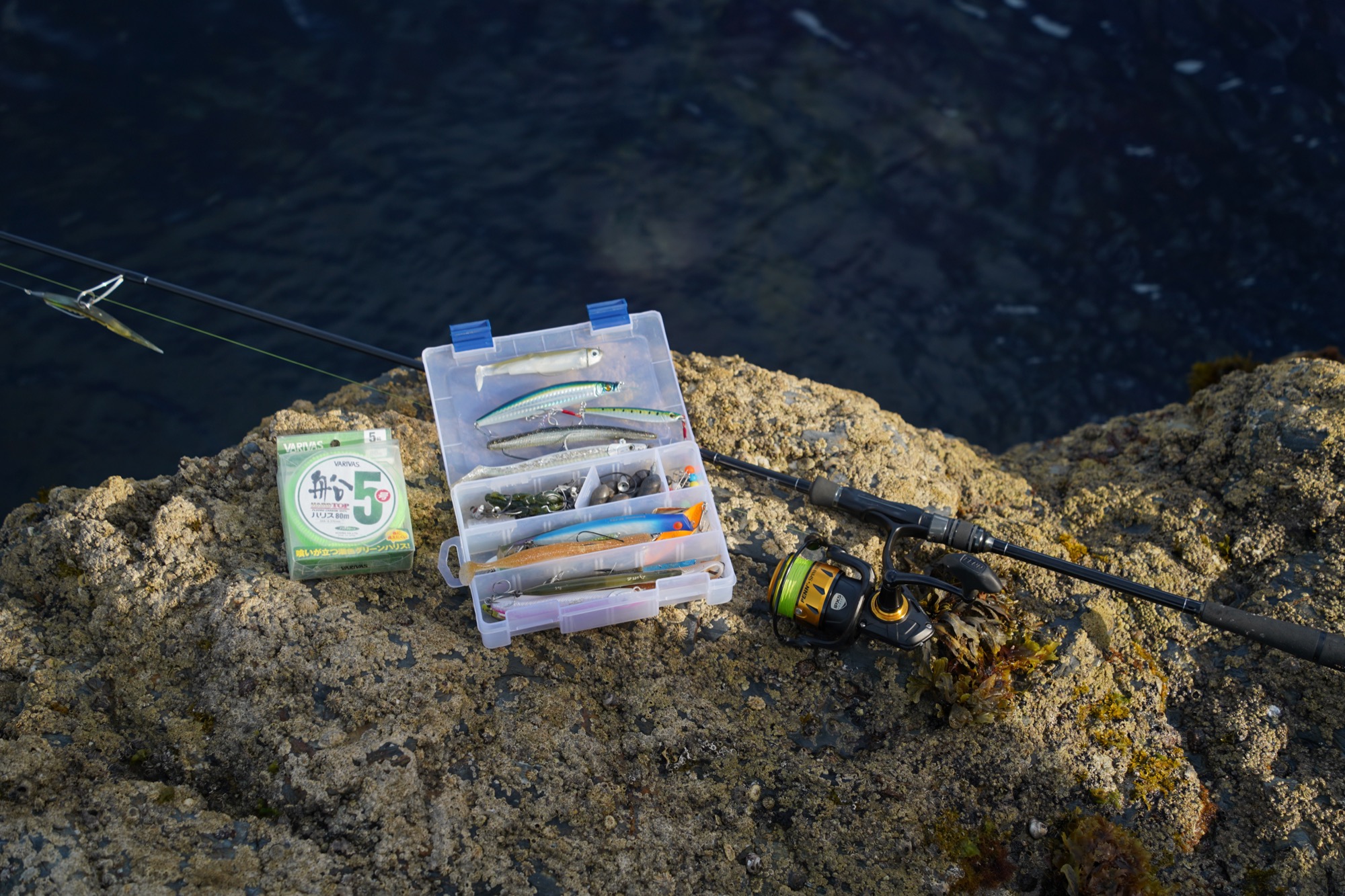
Rock Fishing Approaches & Tackle
Within fishing, you can take hundreds of different approaches and a million different lures to choose from. However, the real skill of fishing is removing the chance and making catching more predictable. That means narrowing down the approach to find what works.
Often, lost tackle is significant, and I’d recommend using a braided line with a long and strong abrasion-resistant leader. The braid will not only enable you to cast further out but also reduce the amount of plastic pollution in the sea from lost tackle. When fishing over rough ground, losing tackle is inevitable. If you’re doing it right, you’ll be fishing right amongst the kelp and rocks. That’s where many species will be.
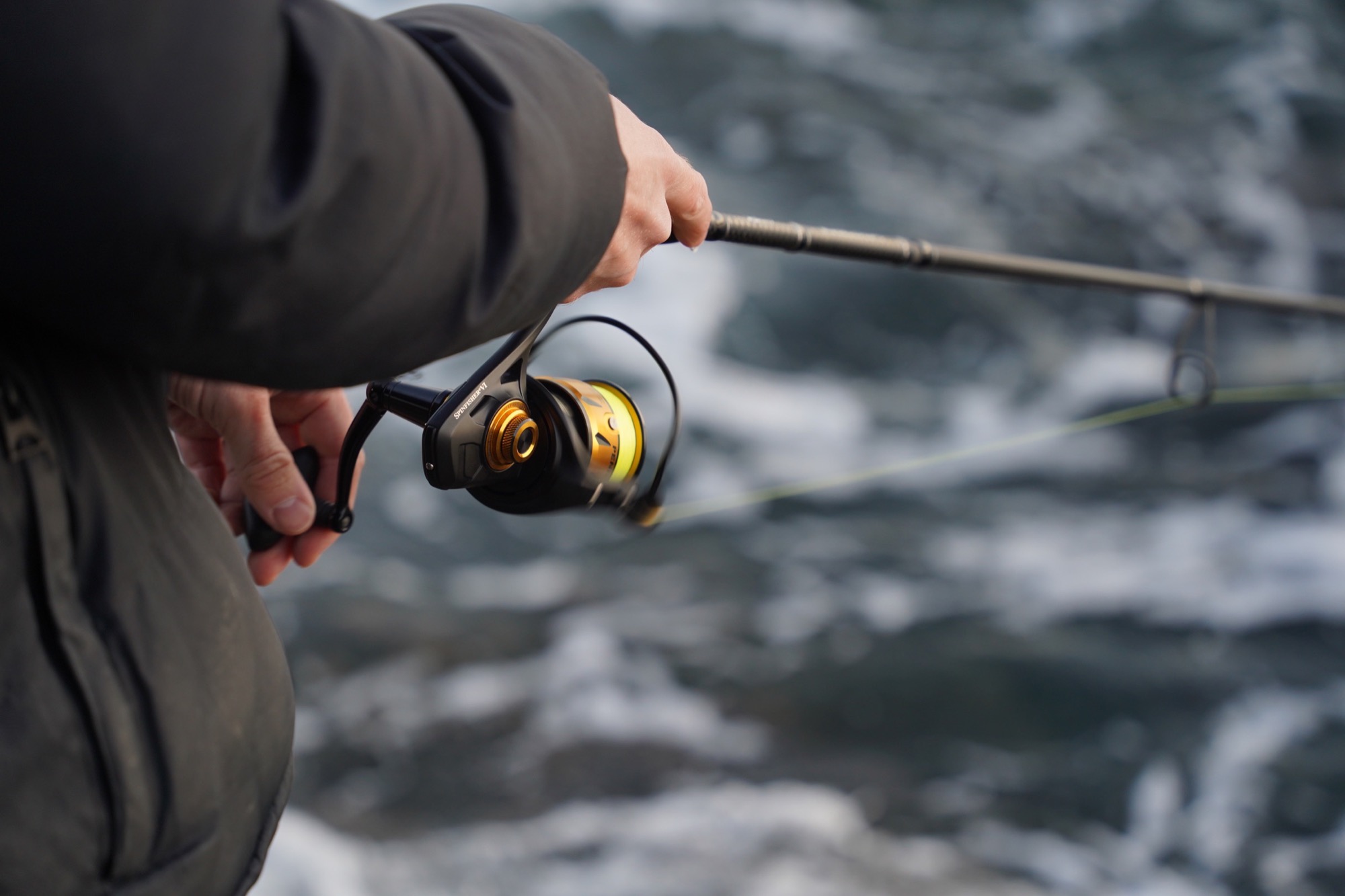
Value of longer rods for some
When rock fishing, you may be better off with a longer rod. If rocks are between you and the water, you need a bit more length. This can help you pull smaller fish up and over the rocks. It can also help get greater distance into your cast if you need it. For this reason, some bass anglers use 10ft rods for spinning. I’s only necessary on the most rugged stretches of the coast, where it isn’t safe or possible to fish directly by the water.
Travel light for mobility on the rocks
It’s also wise to leave most of your tackle at home and travel light on the rocks. It’ll save you the bother of carrying unnecessary kit while trying not to fall over!
Fishing headlights useful for safety
A fishing headlamp is essential when sea fishing anywhere at night. For some species like bass, you need to make sure they never shine onto the water or you’ll spook the fish. Other species like squid and scad are strongly attracted to light.
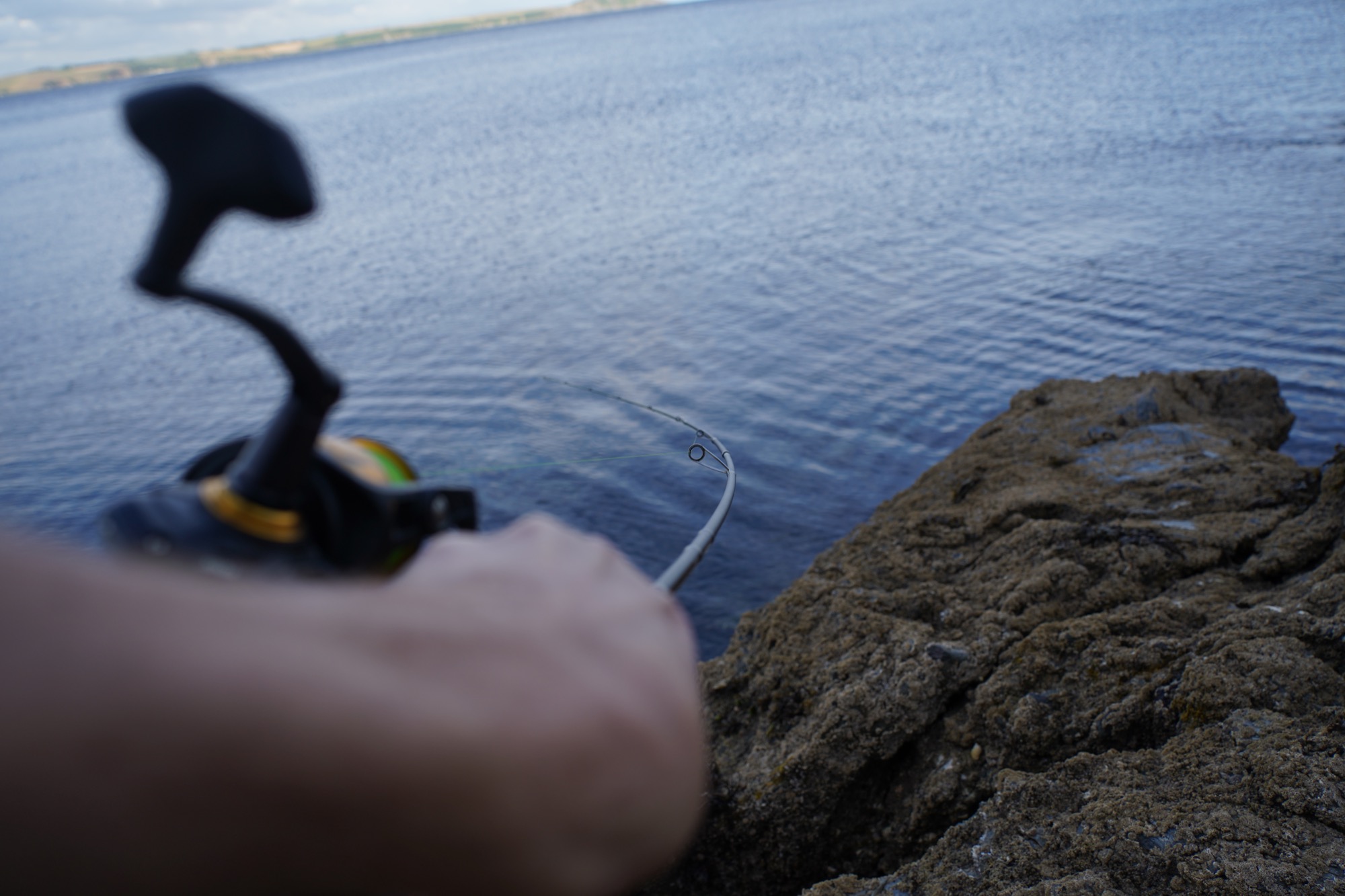
Rock fishing rods
Broadly, you can split lure rods for rock fishing into two types: modern and traditional. Another way of putting it more bluntly is fancy specialist rods and mass-market rods. Outside the UK, in America, the Mediterranean, Hong Kong, and Japan – what we think of in the UK as specialist lure rods are normal. Some brands even release special reels for the UK market that are cheaper and made from lower-quality materials. They know that we Brits are still using rods that haven’t been used in other countries for a couple of decades!
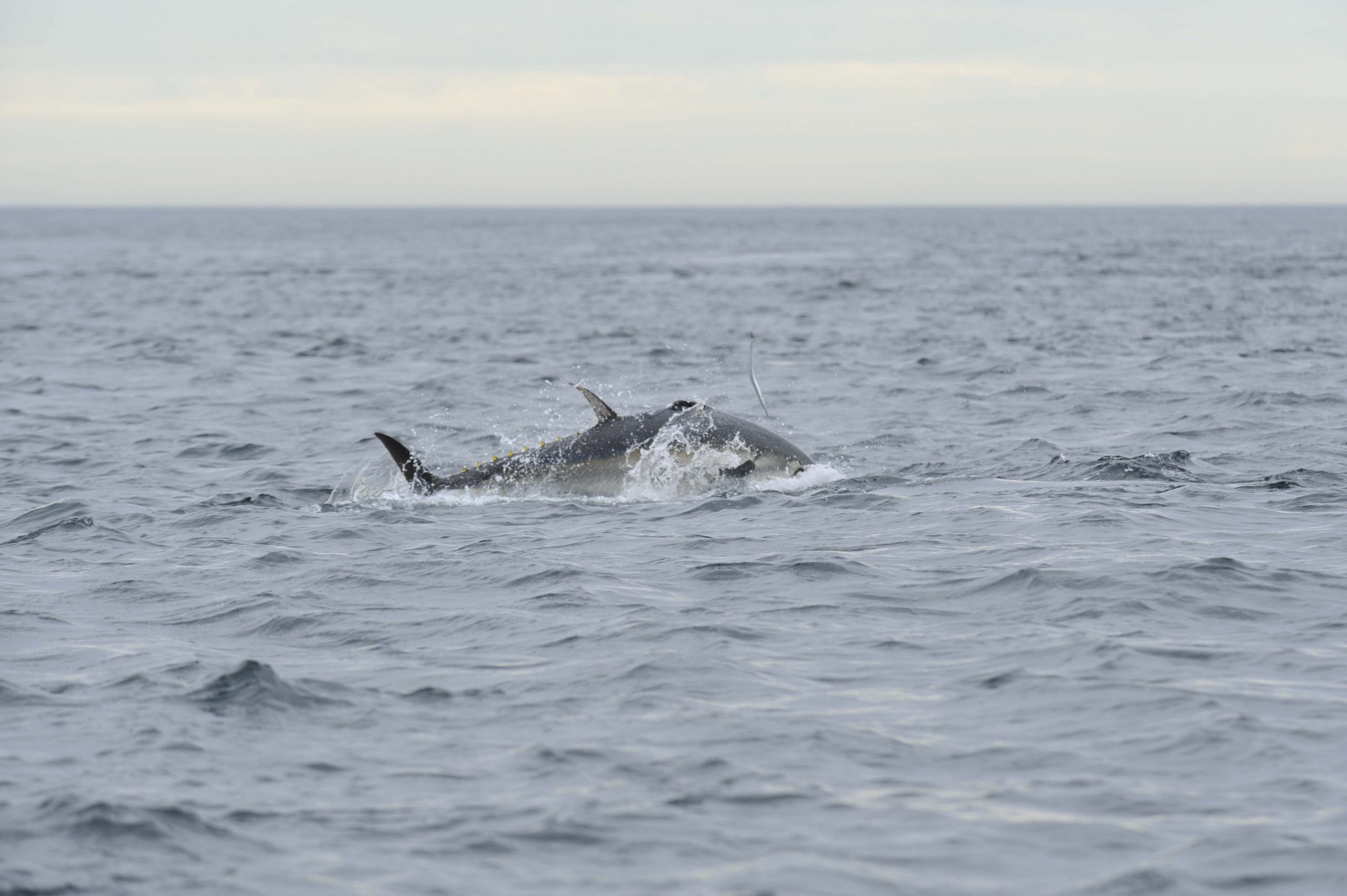
Spinning rods
People who like ‘spinning’ are often anglers who prefer a mixed approach, utilising both bait and lures. They prefer rods and reels that can cast a lead weight and hold the bottom. Or, be used with float rigs or classic, weightier lures like the Dexter Wedge.
LRF, HRF & Modern Bass Rods
Anglers who use LRF, HRF, and Bass Rods are usually committed to only fishing with lures on these setups and tend to spend more on their rods. These rods are significantly lighter with much faster actions. Many consider them to provide much more sport while playing fish since you can feel everything. These rods can also cast light lures without additional weights and allow you to fish with a light braid so you can cast further without the need for the additional weight that compromises lure presentation.
If you are looking for an all-round lure fishing set up, we have a full guide that recommends specific reels for each rod, and exact lines to match.

LRF Rods
LRF Rods cast up to 10g and are generally between 7-8ft. The approach is based around finesse, allowing for lure presentations that are more subtle. This allows many more fish species to be targeted than can be caught on standard lightweight lure gear. Light Rock Fishing originates from Japan where the tactics were developed to target smaller fish species. Overfishing of larger sport species was one factor that drove this. In particular, the Japanese enjoy using LRF for targeting ‘Agi’. This is what we know as Horse Mackerel or Scad, which they like to eat as sashimi.
Targeting wrasse or bass with rods rated to less than 20g
I do not recommend targeting wrasse or bass with an LRF rod, because there is no added sport when catching reasonable-sized specimens, but significant increases in lost fish due to being taken into snags. You can’t stop a 3lb wrasse from bolting into the kelp with a rod that casts 7g if it wants to. However, for targeting pretty much everything else an LRF rod is ideal.
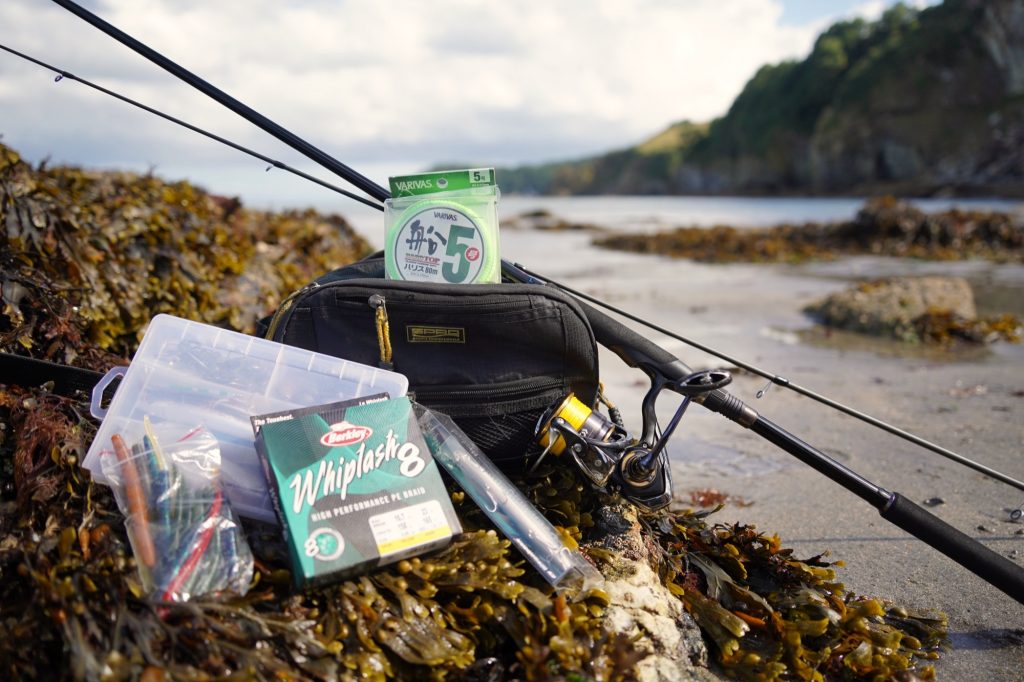
HRF Rods
HRF refers to ‘hard rock fishing’. These rods cast up to 28g/1oz and are paired with size 2500 or 3000 reels. They are between 6-8ft. You’d need to check the full reel guide, as reel sizes vary by manufacturer. HRF techniques are deployed for the targeting of rockfish species around the world. They are designed for bouncing soft plastics over rough ground. In the UK, our rockfish species is the Ballan Wrasse.
These fish smash into soft plastics and fight like hell, crash-diving into the kelp immediately after being hooked. Rock fishing with a HRF rod allows you to feel your lure as is bounces along the bottom. They are much more sensitive than traditional lure rods that might be 9ft and cast 2oz. With experience, you can tell what type of ground your lure is over, or even what type of seaweed you’re going over by the type of resistance you feel.
Bass Rods
There is a lot of crossover between HRF rods and bass rods. Many people use the same rod for both purposes (that is, Wrasse and Bass fishing). However, dedicated bass rods are often a bit longer (8-10ft) and reels are often larger. A ‘heavy’ bass rod casts about 45g, which is the upper limit for a bass rod. A rod like that gives you a bit more grunt from the rod to cast against a prevailing wind. It also gives more manoeuvrability to lift fish out of the surf. This is particularly useful on more rugged coastlines or windy conditions, where you need the power to whack a heavier bass lure out to sea.
A longer rod can be useful if you aren’t able to fish right on the water, such as if there’s white water on the rocks. In fair conditions and calm seas, you can fish very close in with lures with no problems.
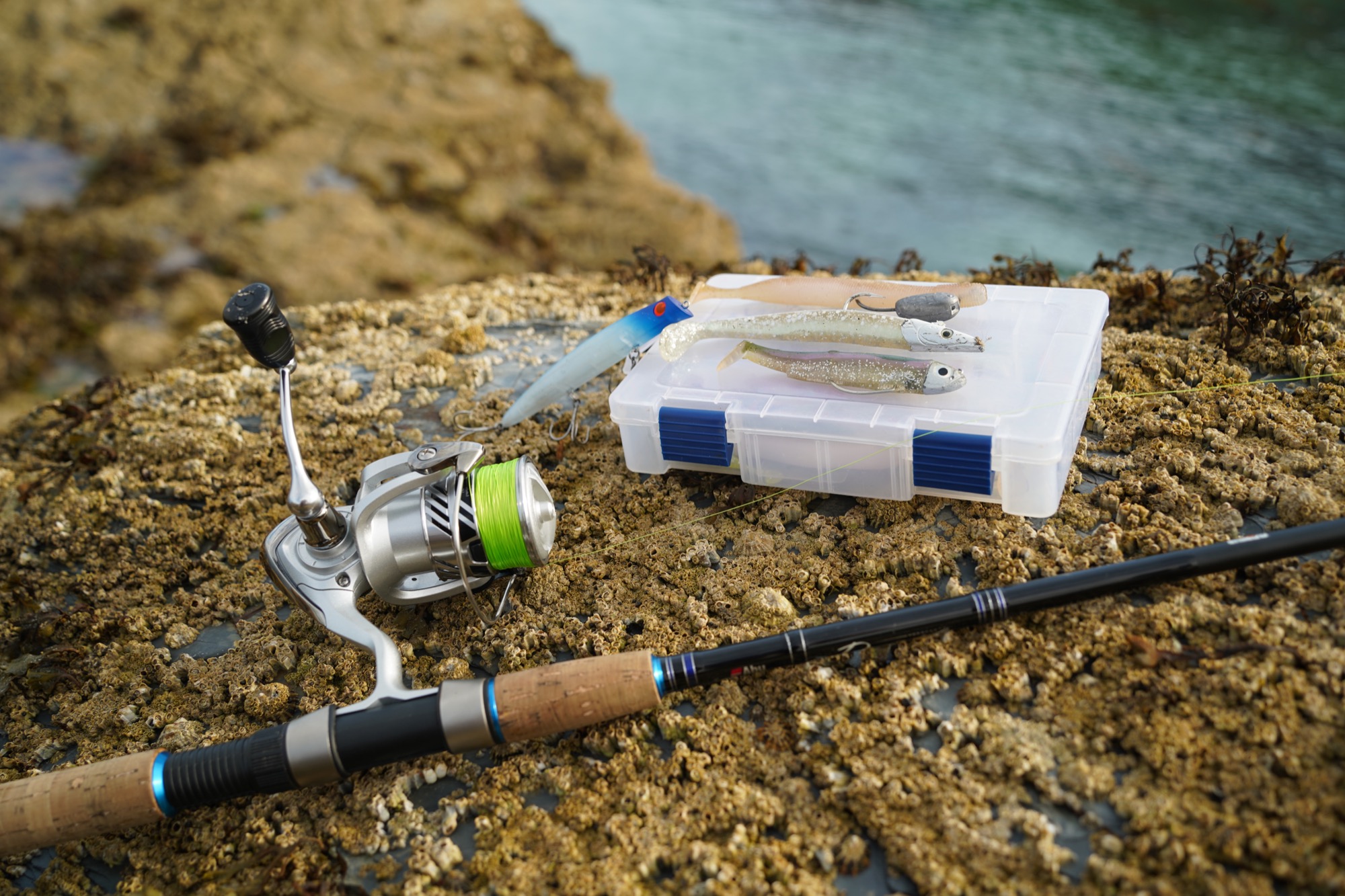
Spinning & General Purpose rods
The word ‘spinning’ refers to the use of ‘spinners’. These are a type of lure that is designed to spin in the water to attract fish. Bait anglers often use it to refer to any type of lure fishing. However, it usually means fishing with more traditional tackle. This means using heavier rods that cast further and be used with heavier lines. This kind of tackle allows you to switch to bottom fishing with lead weights or pull four mackerel up a harbour wall with no rod breakages! With modern lure or bass rods, you would struggle to comfortably lift four mackerel up a harbour wall. A spinning rod of 9ft+ that casts 2oz+ lets you do that. If you go to a harbour wall or rock mark anywhere in the UK, most anglers will have a multi-purpose spinning rod that casts over 3oz.
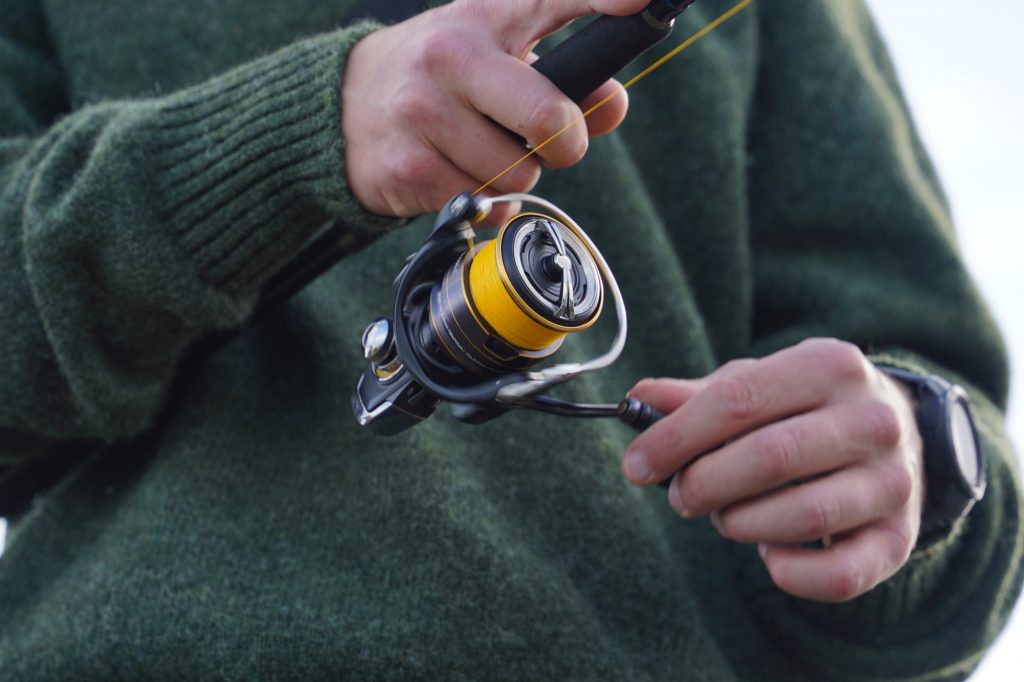
Rock fishing reels
LRF Reels
These reels are 1000-2500 size and are tiny. They can only be used as part of a full LRF set-up.
HRF Reels
Size 3000 reels are used for HRF fishing. If you use a modern lure rod you will need a modern reel to go with it. It’s not straightforward getting the right reel. If you’re using a rod that cost over £60 and casts about 30g/1oz, then you will want to go for a Shimano or Daiwa reel to achieve proper line movement through the smaller, more focused eyelets on your rod. Penn reels, for instance, are nice mid-range reels associated with quality, but they are not designed for use on light modern rods.
Bass Fishing Reels
Size 4000 is generally best for bass fishing. On a lightweight bass fishing set-up (say, an 8ft rod that casts 20g), you might use a 3000 reel. On a powerful 10ft bass set up for the most rugged coasts, you may even use a 5000 size., but 4000 is usually better suited to bass fishing.
Spinning & General Purpose Reels
There are a few general-purpose spinning reels I can recommend that can be paired with heavier, more traditional rods. View the full ‘reels’ guide for more details. Full guide to the best spinning reels here.
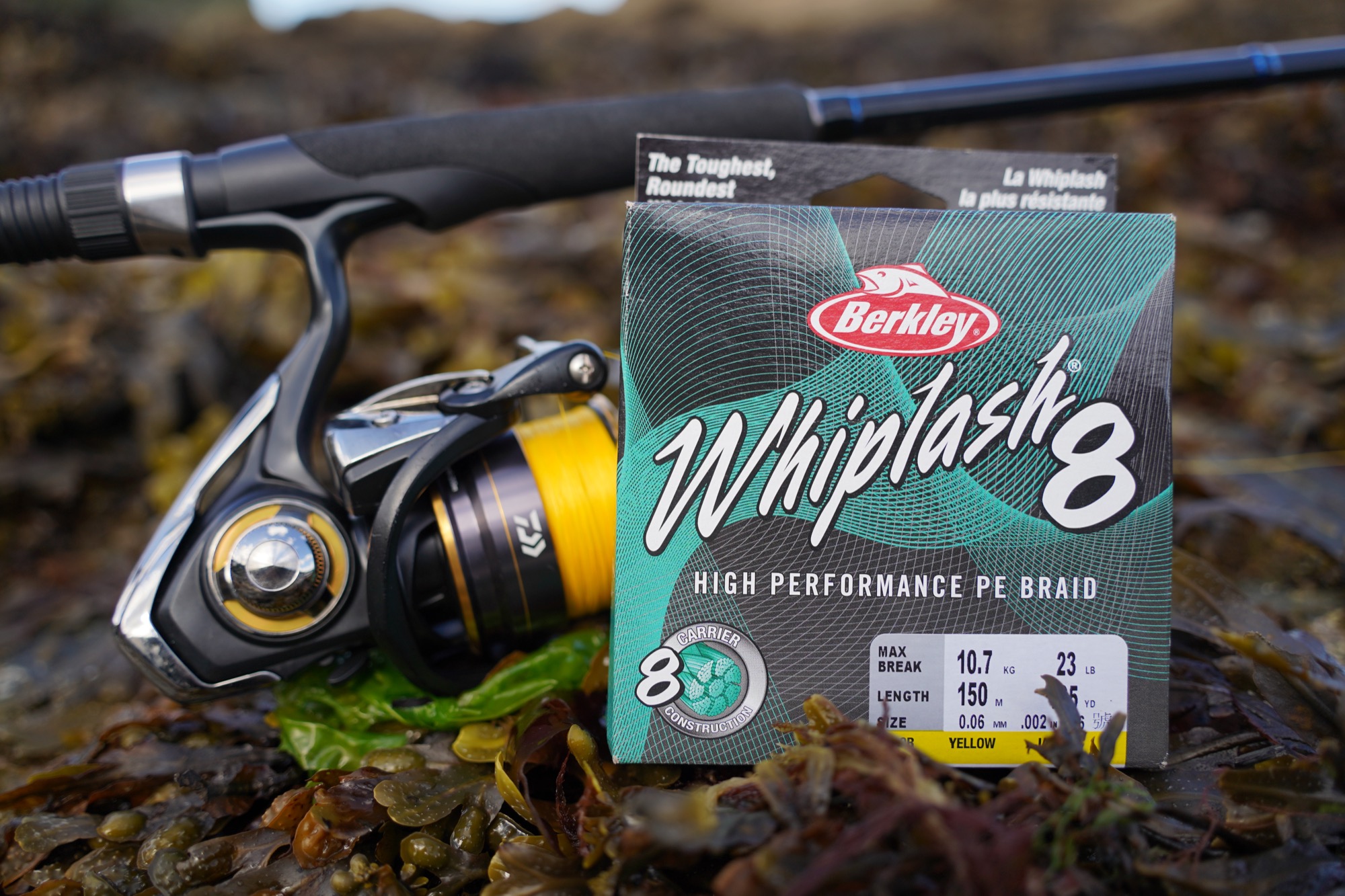
Rock fishing lines
Monofilament line used to be what everyone in the UK used, but then braid came along and changed the game, having certain advantages that left mono largely in the dust. Under a microscope, the braid looks like an interwoven chain of lots of even thinner lines. Braided lines are much more expensive than mono, and although you might imagine they are all similar across the price range this could not be further from the truth.
Cheaper braids that cost about £15-20 are stiff, rigid, and thick relative to their strength. The main way to spot a good braid is to look at the PE rating compared to the strength, which is how thick the line is. A nice braid is thin relative to its strength. After this factor, you can consider how many strands it has. Higher strands are generally better.
The value of some cheaper braids for rock fishing
For wrasse fishing, I prefer to use a cheaper braid. This is because cheaper can mean the line is more abrasion-resistant because it’s less fine. Powerpro, for instance, is great for Wrassing. This is not true of all cheaper braids!
For LRF fishing sadly I cannot recommend any braid under £20. Once you’ve used £50 braid you won’t ever be able to go back, it changes everything and can actually last a long time. Don’t forget, you’re fishing with a lighter leader, so you probably won’t ever lose all your line, you’ll just have to replace it when it gets old and tattered.
Lines need to be considerably stronger when fishing over rough ground from rock marks. When lure fishing, 20lb braid becomes standard.
It’s essential that your fluorocarbon leader is lighter than your braid.
Best Braids for Rock Fishing
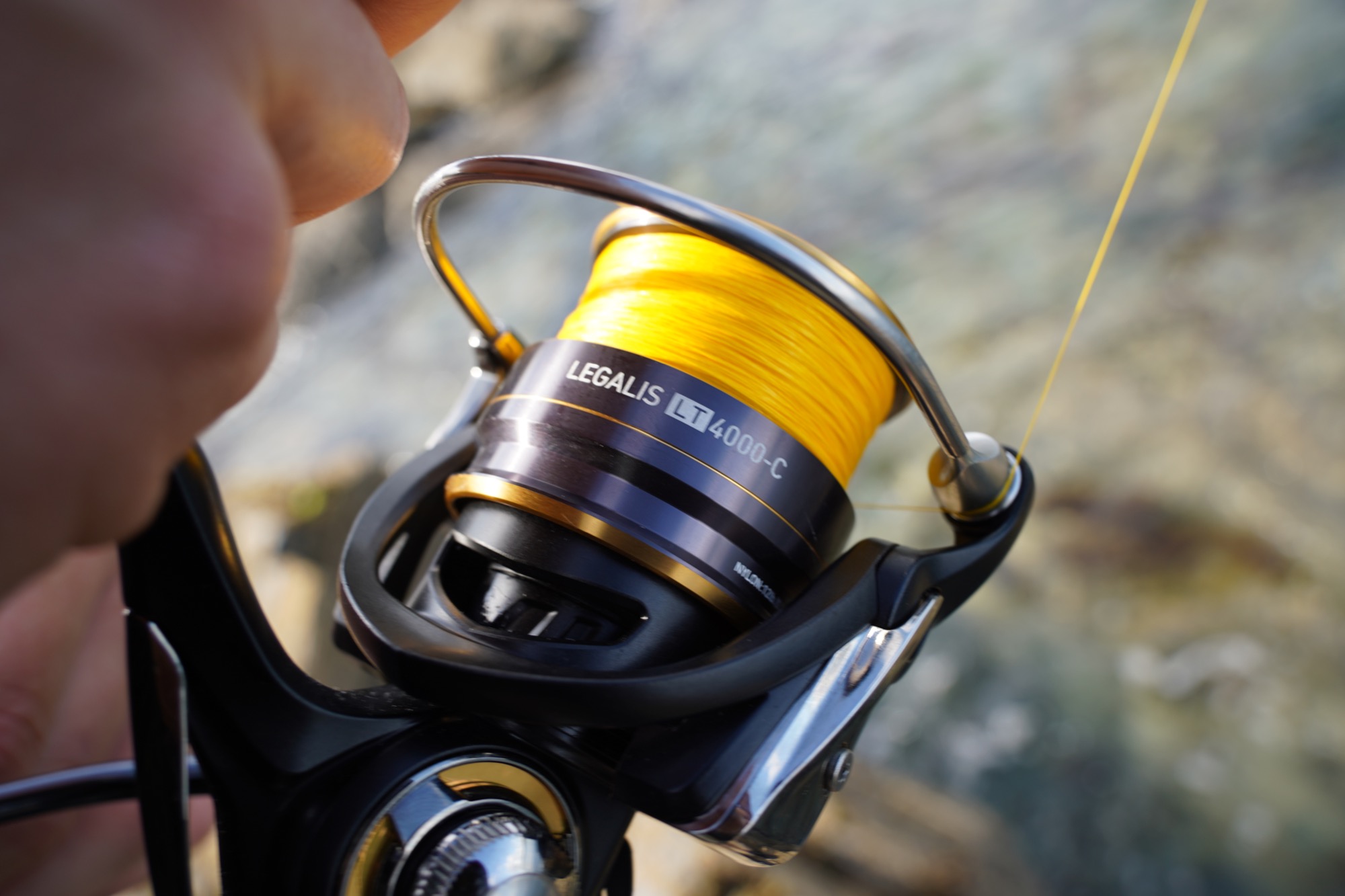
Rock fishing lures
There is a full guide to lures here, so I won’t go into much detail here.
However my experience is that paddle tail soft plastics and hard lures are best over clean ground, and weedless rigs are best used over rough ground (with straight or paddle tails usually working better for me than curly tails, especially for bass).
The Fiiish Minnow provides the best of both with a paddle tail that’s rigged weedless with a heavy enough metal head to be cast with ease. Although expensive, you lose far fewer of these lures than you do equivalent soft plastics that are not weedless. Hard metals are very easily lost when fished over rough ground.
Retrieval & Lure Presentation
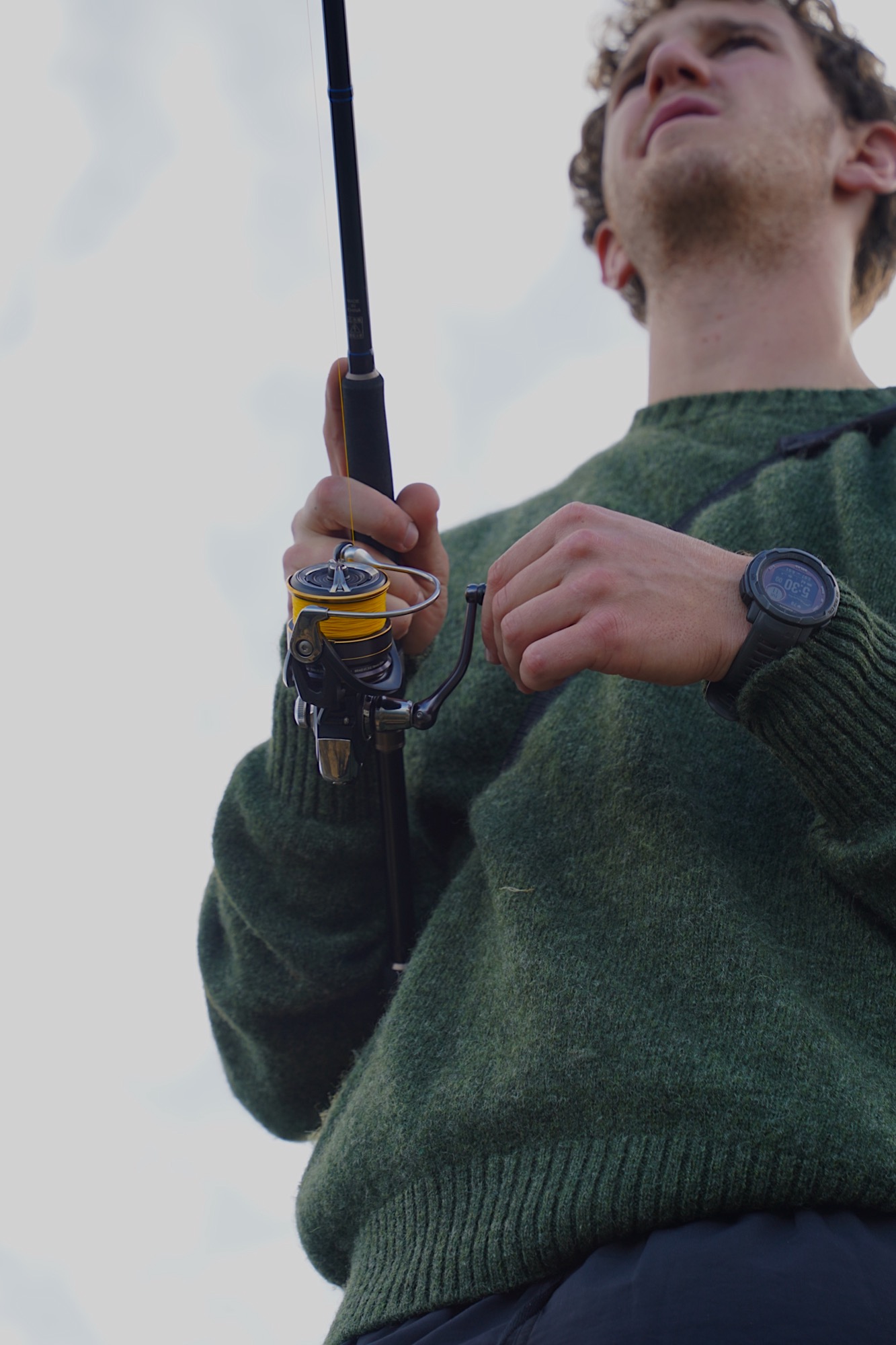
A common mistake many people make when fishing is casting out and immediately retrieving at a set speed. They do this for an entire session without changing the depth of their lure. Often, those who use heavier gear, like large reels, unknowingly keep their lure too high in the water. This reduces their chances of catching fish.
On a day when the fish are lower down, you may never put your lure in front of them. Once you’ve figured out where the fish are feeding, repeat what’s working and reap the rewards. This is why it pays to pay attention to the depths other anglers are fishing at to gauge where the fish are on a given day.
The main ways to retrieve a lure include
Zig zag pattern
Letting it reach the bottom, retrieving steadily for a while and then allowing the lure to sink back down again. Fish will often hit as the lure falls.
Fishing high in the water
Casting and retrieving quickly so that the lure stays high up in the water. This is necessary if fishing without a weedless hook over shallow rough ground.
Intuitively fishing the right depth!
Casting and retrieving steadily after roughly counting down or relying on intuition to know that the lure is at the depth you want it (which comes with experience).
What most lure anglers do
Of course, with each of these approaches, you can twitch the lure to make it dance. Many lure anglers adopt a steady retrieve with a slight sink and draw. This involves speeding up the lure for a few moments by pulling the rod. Then, you reel back in the line as you return the rod to its original position, ensuring there is no slack. New anglers may try to replicate this, especially when reeling in a fish. However, they often create slack in the line each time they return the rod. This can allow fish to escape from the hook. I made this mistake for years!
Rock fishing rigs
Since most of the fish live amongst the kelp, when lure fishing you’re best off using cone weights and weedless hooks and getting a soft plastic lure right into the kelp. The texas rig is best for lure fishing over rocky or weedy ground. You can then slowly retrieve, or even bounce your lure along the bottom, to draw attention from fish. You will catch a lot of Ballan Wrasse if you take this approach.
When lure fishing, the way you fish will be determined by the ground you are fishing over and the lure you’re using.
To a degree, this has been done so well with sea fishing that most of us use the same rigs and lures repeatedly. For instance, the Fiiish Minnow is a lure that solves many problems and makes fishing almost effortlessly easy. It has a paddle tail. You can feel it wag as you retrieve it. It’s weedless so that you can cast it into gullies for Wrasse in the kelp or fish just a few inches below the surface for bass hunting in the shallows. There’s no fumbling about with cone weights or switching back to a hard lure so you can cast further. It’s versatile and manages to avoid many of the trade-offs with performance that other lures have to make. In life, it’s nice to have some things that simply work.
This Fiiish Minnow is so effective that it makes its users, like myself, suck at fishing because we can’t be bothered to fish with much else! So, if you don’t want to suck at fishing, don’t buy yourself one, but if you want an easy life…
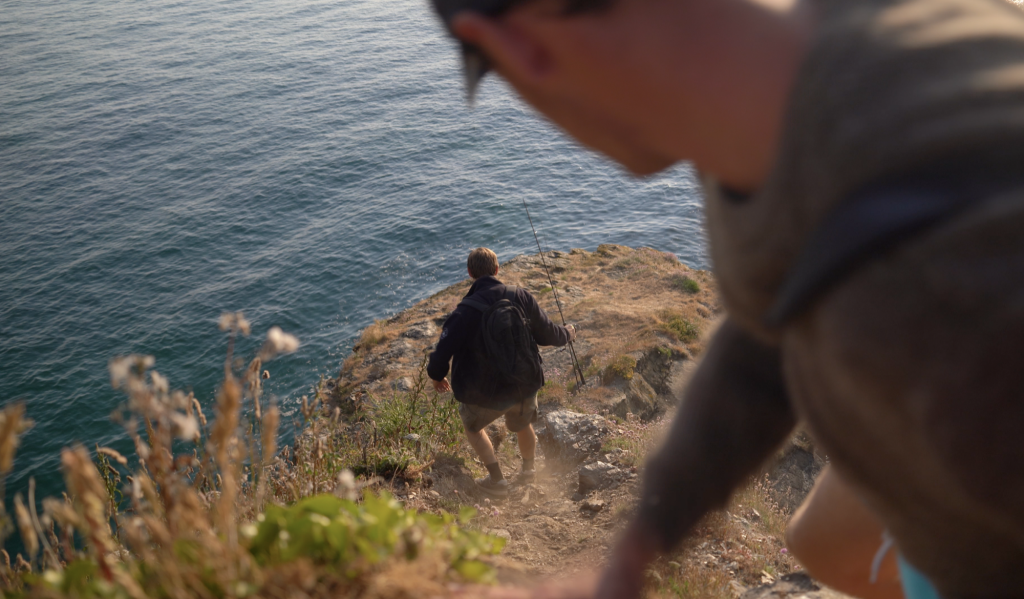
Exploring Rock Fishing Marks
A huge part of rock fishing is about exploring new areas of coastline looking for the best rock marks, and trying to predict what, when, where and how you ought to fish. To find the best marks you need to be willing to try your hand at coastal exploration with Google Maps and you need to know your local coastal paths. For rough guides (which should not be used as a primary source, for safety reasons) – check out our guides to fishing in Cornwall, Devon, East Scotland and West Scotland.
If you seek out your own marks, it may be that nobody has fished with lures in the area for months or years. This is as close to paradise as sea fishing gets.
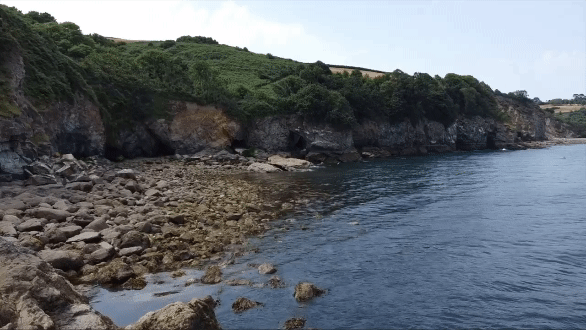
Rock marks can be ‘burned’ by overfishing (specifically of non-pelagic species)
Fishing from rocks offers the opportunity to explore marks that aren’t fished much – if at all – by other anglers. The best fishing ground in the country is probably a rock mark somewhere that nobody has bothered to fish! To find these places, you need a good pair of shoes to explore the coast and Google Maps to look for promising spots. Needless to say, rock fishing is a dangerous business. You need a buddy for most marks!
For this reason, fishing from rocks places demands on the angler that other places don’t. You’re forced to pack light, fish proactively and explore more ground to find the best spots. If you’re new to fishing don’t let this put you off. Rock fishing can be as easy as wandering down to the far end of a beach, walking over rocks for 2 minutes and casting out.
Rocky outcrops from beaches can be excellent for both bass fishing and bottom fishing as it can allow you to get out past the breakers and fish directly into deeper water. While you can catch all the same species from the rocks as you might from a pier or jetty, rock marks tend to produce a lot more pollack and wrasse.
Use Google Maps
There’s nothing more satisfying in all of angling than discovering a rich rock mark. Only you, or you and a small handful of others, know these spots. Exceptional mobility is necessary to reach these spots. They can be dangerous, especially when fishing alone. The only real way to discover these spots involves walking along the coastal path. You must look for ways to descend the cliff. I’m not recommending this, I’m simply stating what many anglers do to find good marks. For instance, you might know an estuary near you that fishes well. You might roam the coast path. Look for any small paths leading towards the sea. Follow them with a buddy. The harder the place is to find or access, the fewer people will fish there. This increases the likelihood of it being a good spot. And the higher the chance of fatality, too…
Checking tides
You need to know the tide times so you don’t get in trouble of course, but the tide also will determine the quality of the fishing wherever you go by the sea. Different places fish well at different tides, but usually, the best fishing is the hour before and after high tide. Bigger tides are also often better. Some marks work well at low tide. These are less common and more precious for that reason!
Safety and the weather
Lure fishing from the rocks is best done in low wind and clearer water is better than muddy brown, so fair weather tends to be better. This is particularly true of Wrasse, that love calm conditions.
For bass fishing, they feed on the fry that gets lost in the churn. That’s where you will catch the most fish—areas of white water and places with lots of water movement. Bass fishing can be a dangerous business for anyone, and people do get in serious trouble or die. It’s a thrill to be in such a chaotic, animated environment and see these silver predators feeding just beyond the waves.
Whether you’re a serious bass angler or an amateur starting out, it’s a good idea to buy a life jacket! Rock marks can be treacherous with slippery slime-coated rocks. Huge drop-offs into frothing water and tides that can sneak up on you and leave you trapped…
UK Rock Fishing Species
Marine environments around rocky coasts are incredibly abundant compared to the open sea. Bass, wrasse and a huge number of other species thrive over the broken ground. The various seaweeds that latch themselves onto rocks provide the foundations for a habitat with extraordinary biodiversity. The most common and popular species to target from the rocks include bass, pollack, conger, bull huss and wrasse. With lures, the fishing generally revolves around bass, wrasse and pollack. You can of course also target mackerel, garfish and other pelagic species. Though they are no more likely to be found at a rock mark than in the open sea.
Since many larger fish species love underwater structures like wrecks, boulder fields, etc. You will find that larger species you wouldn’t catch from a harbour wall sometimes come close to shore at certain deep water rock marks. It’s not uncommon to see larger sharks, big conger and larger coalfish and pollack caught from rock marks in the UK.
When lure fishing at a rock mark, much like when lure fishing a harbour wall the first place I’ll cast is directly across the coast. This way I’m fishing right up against the rocks themselves. A lot of fish, especially wrasse, will hug the very rocks you’re fishing from. On a clear day, you can sight fish by your feet for 5lb wrasse.
General Rock Fishing Advice
Once you know how to cast and retrieve without slack line, set your drag properly, tie a decent knot and use a decent leader and lure, it will mostly come down to location choice. And timing. If you fish a lot, I’m sure you have your spots where you know exactly where to cast to have a good chance at catching a particular species.
I’ll leave you with a few some mistakes to avoid…
- Fishing with mackerel feathers over rough ground, so you limit the species you’re likely to catch and lose tackle to snags all the time.
- Using a rod that’s too heavy, so you aren’t able to easily detect where the bottom is and spend the whole session in snags.
- Using thick monofilament line that tangles easily and makes it impossible to fish with lighter lures
- Using lures with hooks that are too large even when you aren’t having any luck catching bass or larger pollack
- Fishing with weights over 1oz/28g, so that your lure falls quickly into the kelp and you are forced to retrieve quickly to keep it up. This prevents you from trying other retrieval styles. (this is less relevant at very deep water marks).
- If you are using a cheaper or more old-school fishing kit, your best bet is to float fish rather than fish with lures, or else stick with mackerel feathers but seek out areas of sandy ground to avoid snags.
Surf fishing for big bass with Grant Woodgate
Surf fishing for big bass with Samson Lures | Masterclass with Grant Woodgate Few people…
The best braided fishing lines, ranked
The best braided fishing lines, ranked We look at the best braids, from the budget…
The best bass rods | Finding your next stick
The best bass rods | Finding your next stick The most common bass fishing setup…
The UK’s Best Bass Lures
The UK’s Best Bass Lures Let’s start by looking at the three bass lures that…
The Ideal Lure Fishing Set-Up
Lure fishing set ups, everything you need. In this article, I will recommend specific rods,…
Lure Fishing UK | Beginners Guide
Lure Fishing UK | Beginners Guide This guide to lure fishing for beginners covers the…

